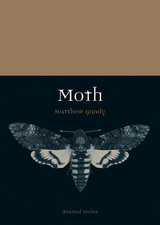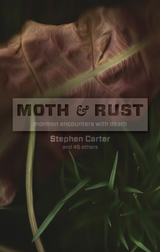3 books about Moth

Desire of the Moth
a novel
Champa Bilwakesh
UpSet Press, 2017
A fifteen-year-old widow runs across a bridge to catch a train bound for Trichi. Sowmya is running away to make sense of the events that had seized her body and her mind, and had ripped apart her world. She is determined to flee her destiny of numbing isolation within her community, the Brahmins of the Thanjavur district in South India. Her plans pivot when she meets a devadasi--an aging dancer--in her compartment. When the woman Mallika opens her drawstring bag and buys Sowmya her dinner, Sowmya recognizes what she needs to overcome her own condition, that of a young woman in possession of a thin cotton sari, a head shorn clean, and little else. She asks Mallika how she too can achieve that kind of power--the power to open a bag and pull out money. Thus begins Sowmya's transformation in the city by the sea, Madras, which is in the grip of its own political and social changes while India is struggling to seize its independence from the imperial British raj. Here she learns the beauty of dance from Mallika, and the sweetness and agony of falling in love with a married man. The cinema brings unimagined opportunities and all the power and riches that she could desire, but it also consumes her relentlessly. When a letter arrives, Sowmya begins her quest to regain everything that had been lost when she once lived in that small village tucked into a little bend of the Kaveri River.
Hear Champa Bilwakesh reading from Desire of the Moth here: http://voicethread.com/myvoice/#thread/5863247/30058528/31699244
Hear Champa Bilwakesh reading from Desire of the Moth here: http://voicethread.com/myvoice/#thread/5863247/30058528/31699244
[more]

Moth
Matthew Gandy
Reaktion Books, 2016
Unlike their gaudy day-flying cousins, moths seem to reside in the shadows as denizens of the night, circling around streetlights or caught momentarily in the glare of headlights on a country lane. As Matthew Gandy demonstrates in this book, however, there are many more species of day-flying moths than there are butterflies, and many rival butterflies in a dazzling range of markings.
Gandy shows that the study of moths formed an integral part of early natural history. Many thousands of drawings, paintings, and physical specimens remain in museum collections, and in recent years there has been a renewed surge of interest facilitated by advances in digital photography, the internet, and new cartographic projects that have enabled direct collaboration between amateur experts and scientific research projects. He explores the rich history of vernacular names, which speaks to a significant place for moths in early cultures of nature. Names such as the Merveille-du-Jour, the Green Brindled Crescent, or the Clifden Nonpareil evoke a sense of wonder that connects disparate fields such as folklore, the history of place, and early scientific texts. With wingspans ranging in size from a few millimetres to nearly a foot, moths display an extraordinary diversity of evolutionary adaptions, which Gandy captures here.
Gandy shows that the study of moths formed an integral part of early natural history. Many thousands of drawings, paintings, and physical specimens remain in museum collections, and in recent years there has been a renewed surge of interest facilitated by advances in digital photography, the internet, and new cartographic projects that have enabled direct collaboration between amateur experts and scientific research projects. He explores the rich history of vernacular names, which speaks to a significant place for moths in early cultures of nature. Names such as the Merveille-du-Jour, the Green Brindled Crescent, or the Clifden Nonpareil evoke a sense of wonder that connects disparate fields such as folklore, the history of place, and early scientific texts. With wingspans ranging in size from a few millimetres to nearly a foot, moths display an extraordinary diversity of evolutionary adaptions, which Gandy captures here.
[more]

Moth and Rust
Mormon Encounters with Death
Steven Carter
Signature Books, 2017
In Mormonism we are sometimes seemingly casual
about death: it’s a veil or a mission call to the spirit
world. But our actual encounters with the reality of
death inevitably change us in ways that are difficult
to articulate.
In this collection, Mormon writers wrestle with
mortality and its aftermath. A family sings a hesitant
rendition of Happy Birthday to a grief-stricken
mother who buried her toddler just a few hours earlier;
an agnostic son decides he’s Mormon enough to
arrange a funeral for his believing father.
Some essays use death as a means to understand
faith. One author imagines a world where Heavenly
Mother visits her children in the form of their
female ancestors, appearing to her descendants in
times of grief or pain.
Others address practicalities: how do you protect
your children from death while still allowing them
to experience the world; how do you get through
one more nausea-ridden day of cancer treatment?
Still others delve into death’s questions: does the
overwhelming suffering that occurs in the animal
kingdom have a function in the “plan of happiness”?
Sometimes humorous, sometimes heartbreaking,
always thought-provoking, these personal essays,
poems, and stories may never be heard at a Mormon
funeral. But they probably should be.
about death: it’s a veil or a mission call to the spirit
world. But our actual encounters with the reality of
death inevitably change us in ways that are difficult
to articulate.
In this collection, Mormon writers wrestle with
mortality and its aftermath. A family sings a hesitant
rendition of Happy Birthday to a grief-stricken
mother who buried her toddler just a few hours earlier;
an agnostic son decides he’s Mormon enough to
arrange a funeral for his believing father.
Some essays use death as a means to understand
faith. One author imagines a world where Heavenly
Mother visits her children in the form of their
female ancestors, appearing to her descendants in
times of grief or pain.
Others address practicalities: how do you protect
your children from death while still allowing them
to experience the world; how do you get through
one more nausea-ridden day of cancer treatment?
Still others delve into death’s questions: does the
overwhelming suffering that occurs in the animal
kingdom have a function in the “plan of happiness”?
Sometimes humorous, sometimes heartbreaking,
always thought-provoking, these personal essays,
poems, and stories may never be heard at a Mormon
funeral. But they probably should be.
[more]
READERS
Browse our collection.
PUBLISHERS
See BiblioVault's publisher services.
STUDENT SERVICES
Files for college accessibility offices.
UChicago Accessibility Resources
home | accessibility | search | about | contact us
BiblioVault ® 2001 - 2024
The University of Chicago Press









